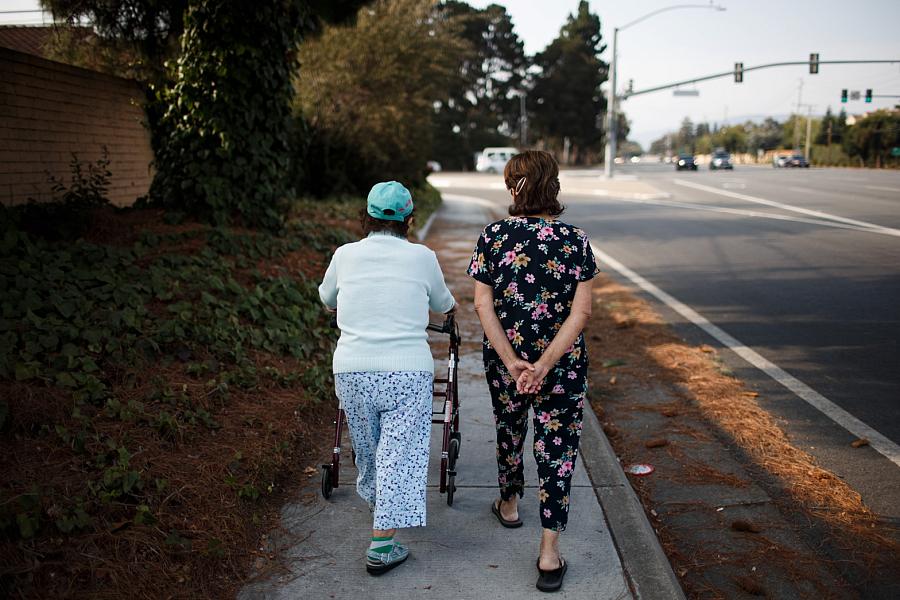What we found digging into an elder care landscape rocked by the pandemic

Ana Nicho Luu, 66, right, takes her mother, Maura Nicho, 90, who has Alzheimer’s disease, for a short walk around their Santa Clara home on Aug. 12, 2021.
(Dai Sugano/Bay Area News Group)
There is no elder care system in California. Instead, there is a patchwork of options. And because, with limited exceptions, we don’t dedicate public funds to long-term daily care, many options are wildly out of reach to families without significant resources.
The COVID-19 pandemic made all of this abundantly clear, and showed just how fragile the existing options are, from assisted living homes overrun by infectious disease to at-home care delivered by underpaid workers who were not prioritized for protective gear when the pandemic hit.
While we may not have another pandemic like the one that has gripped the world for the last two years in our lifetime, we felt it was important to explore the problems it exposed in our elder care system — problems that, in many cases, were decades old and will not be solved anytime soon.
We focused on elder care in part because seniors make up a growing proportion of California’s overall population. About 16% of our state is over 65, up from just 9% in 1970. Many of our Bay Area News Group — particularly our print subscribers — also fall into this category.
Ultimately, we tried to unpack a piece of the elder care story through the eyes of four families. These families each grappled with the need to find care for elders and made vastly different choices in the process. One family moved into an assisted living facility during the winter 2020 surge in COVID cases. One woman moved her frail mother out of a memory care facility and into her dining room as the pandemic first hit. Another woman relied on professional caregivers, while another — who had worked as a paid caregiver for other families — provided the care herself.
Our goal was to weave in the broader policy discussion — touching on a series of bills in Sacramento aimed at reforming the nursing home industry and a federal push to boost funding for caregivers — into the piece without getting bogged down. We also put together a companion piece on care options, costs and important forms families should know about. Finally, we held a webinar attended by hundreds of people, which featured some of the families in the story, as well as a geriatrician and a social worker. It was one of our most-attended live events ever, which I think speaks to the need for stories focused on seniors, a demographic that is too often overlooked or excluded.
The reporting process was not without its challenges. What we thought would be a process of finding families to write about through visits to senior centers, assisted living facilities and other organizations instead initially played out online. Senior centers were still closed and facilities generally weren’t open to visitors because of COVID-19. Instead, we spoke first with advocacy organizations, nonprofits and geriatricians, who connected us with families. Getting families to go on the record was also difficult. We spoke with a number of people who do not appear anywhere in the story about their (sometimes traumatic) experiences with elder care, but many were reluctant to speak openly because they feared reprisal from facilities still caring for their loved ones or other blowback. And families were sometimes reluctant to discuss finances.
As with most long-term reporting, it was important to build relationships and trust with the families we wrote about, and to internalize that what for us might be one project was for them potentially a once-in-a-lifetime experience that involved sharing deeply personal stories.
In the end, we were able to touch upon just a fraction of the elder care landscape. The good news is that there are plenty of other stories to tell. And while there are gaps in accessible information and data, the state does make available nursing home inspection reports, and COVID cases and deaths for various facilities. There are a number of studies from researchers like Charlene Harrington at UC San Francisco that delve into the links between COVID-19 infections and deaths and factors like staffing levels, ownership status and size. Reporters could compare facilities that weathered the pandemic well and those that did not. What went right, what went wrong and why? What needs to change?
Lawmakers passed some legislation but other bills — including one that would limit nursing home squatting, where people or companies run nursing homes without state approval — have stalled amid intense opposition. They deserve continued attention, as does the implementation of those passed.
There is much more to be written about the workers who put their lives on the line, often with very little protection, to care for seniors. And then of course there is the broader thorny question of whether the state or country will move to include elder care as a public benefit.
**

